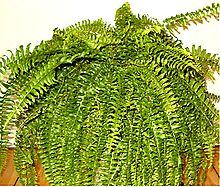Nephrolepis
| Nephrolepis | |
|---|---|
 | |
| Nephrolepis exaltata | |
| Scientific classification | |
| Kingdom: | Plantae |
| Clade: | Tracheophytes |
| Division: | Polypodiophyta |
| Class: | Polypodiopsida |
| Order: | Polypodiales |
| Suborder: | Polypodiineae |
| Family: | Nephrolepidaceae Pic.Serm. |
| Genus: | Nephrolepis Schott |
| Type species | |
| Nephrolepis exaltata (L.) Schott | |
| Species | |
| See text | |
| Synonyms | |
| |
Nephrolepis is a genus of about 30 species of ferns. It is the only genus in the family Nephrolepidaceae, placed in the suborder Aspleniineae (eupolypods I) of the order Polypodiales in the Pteridophyte Phylogeny Group classification of 2016 (PPG I).[1] (It is placed in the Dryopteridaceae in some other classifications.[2]) The genus is commonly referred to as macho ferns or Boston ferns.[citation needed] The fronds are long and narrow, and once-pinnate, in the case of one Bornean species reaching thirty feet (nine meters) in length.[3]
Phylogeny
The following cladogram for the suborder Polypodiineae (eupolypods I), based on the consensus cladogram in the Pteridophyte Phylogeny Group classification of 2016 (PPG I),[1] shows a likely phylogenetic relationship between Nephrolepidaceae and the other families of the clade.
| External phylogeny[1] | Internal phylogeny[4][5] | ||||||||||||||||||||||||||||||||||||||||||||||||||||||||||||||||||||||||||||||||||||||||||||||||||||||||||||||||||
|---|---|---|---|---|---|---|---|---|---|---|---|---|---|---|---|---|---|---|---|---|---|---|---|---|---|---|---|---|---|---|---|---|---|---|---|---|---|---|---|---|---|---|---|---|---|---|---|---|---|---|---|---|---|---|---|---|---|---|---|---|---|---|---|---|---|---|---|---|---|---|---|---|---|---|---|---|---|---|---|---|---|---|---|---|---|---|---|---|---|---|---|---|---|---|---|---|---|---|---|---|---|---|---|---|---|---|---|---|---|---|---|---|---|---|---|
|
|
Selected species
- Nephrolepis biserrata (Sw.) Schott. (syn. Aspidium bisseratum Sw., Aspidium acutum Schkuhr, Nephrolepis acuta (Schkuhr) C. Presl, Polypodium puctulatum Poir)
- Nephrolepis cordifolia (L.) C. Presl (syn. Polypodium cordifolium L., Nephrolepis tuberosa (Bory ex Willd.) C. Presl, Aspidium tuberosum Bory ex Willd.)
- Nephrolepis exaltata (L.) Schott (syn. Polypodium exaltatum L.)
- Nephrolepis falcata
- Nephrolepis multiflora (Roxb.) F.M. Jarret ex C.V. Morton (syn. Davallia multiflora Roxb.)
- Nephrolepis obliterata
- Nephrolepis pectinata (Willd.) Schott (syn. Aspidium pectinatum Willd.)
- Nephrolepis tuberosa
Some species of Nephrolepis are grown as ornamental plants. Nephrolepis exaltata and Nephrolepis obliterata are reported to be good plants for cleaning indoor air.[6]
Some Nephrolepis species may prove to be a good source of new antimicrobial chemicals.[7]
References
- ^ a b c PPG I (2016), "A community-derived classification for extant lycophytes and ferns", Journal of Systematics and Evolution, 54 (6): 563–603, doi:10.1111/jse.12229, S2CID 39980610
- ^ USDA: Nephrolepis; family Dryopteridaceae. accessed 7 Sept. 2016.
- ^ Finn, Judith; Parsons, Jerry (Spring 1996). "A Mind-Boggling Variety of Life". Newsletter of the Univ. Of Calif. Botanic Gardens at Berkeley. 21 (2): 2.
- ^ Nitta, Joel H.; Schuettpelz, Eric; Ramírez-Barahona, Santiago; Iwasaki, Wataru; et al. (2022). "An Open and Continuously Updated Fern Tree of Life". Frontiers in Plant Science. 13: 909768. doi:10.3389/fpls.2022.909768. PMC 9449725. PMID 36092417.
- ^ "Tree viewer: interactive visualization of FTOL". FTOL v1.3.0. 2022. Retrieved 12 December 2022.
- ^ Kent D. Kobayashi; Andrew J. Kaufman; John Griffis & James McConnell (2007). "Using Houseplants to Clean Indoor Air" (PDF). Cooperative Extension Service, College of Tropical Agriculture and Human Resources University of Hawai'i at Manoa: Ornamentals and Flowers. OF-37.
- ^ Rani D, Khare PB, Dantu PK"In Vitro Antibacterial and Antifungal Properties of Aqueous and Non-Aqueous Frond Extracts of Psilotum nudum, Nephrolepis biserrata and Nephrolepis cordifolia." Indian J Pharm Sci. 2010 Nov;72(6):818-22
Further reading
- Hennequin, S., Hovenkamp, P., Christenhusz, M.J.M. & Schneider, H. (2010) Phylogenetics and biogeography of Nephrolepis – a tale of old settlers and young tramps. Bot. J. Linn. Soc. 164(2): 113–127. doi:10.1111/j.1095-8339.2010.01076.x
- Lorenzi, H. & Souza, M. S. (2001). Plantas Ornamentais no Brasil: arbustivas, herbáceas e trepadeiras. Plantarum ISBN 85-86714-12-7
External links

- USDA Plants Profile for Nephrolepis (swordfern)
- Nephrolepis biserrata At: Nephrolepis At: Biodiversity Database At: Cook Islands Biodiversity Website
- v
- t
- e
- Domain
- Archaea
- Bacteria
- Eukaryota
- (major groups
- Excavata
- Diaphoretickes
- Hacrobia
- Cryptista
- Rhizaria
- Alveolata
- Stramenopiles
- Plants
- Hacrobia
- Amorphea
- Amoebozoa
- Opisthokonta
- Animals
- Fungi
- Mesomycetozoea)
| Archaeplastida |
| ||||||||||||||||||||||||||||||||||||||
|---|---|---|---|---|---|---|---|---|---|---|---|---|---|---|---|---|---|---|---|---|---|---|---|---|---|---|---|---|---|---|---|---|---|---|---|---|---|---|---|
Embryophytes or Plantae sensu strictissimo | |||||||||||||||||||||||||||||||||||||||||||||||||||||
|---|---|---|---|---|---|---|---|---|---|---|---|---|---|---|---|---|---|---|---|---|---|---|---|---|---|---|---|---|---|---|---|---|---|---|---|---|---|---|---|---|---|---|---|---|---|---|---|---|---|---|---|---|---|
| |||||||||||||||||||||||||||||||||||||||||||||||||||||











